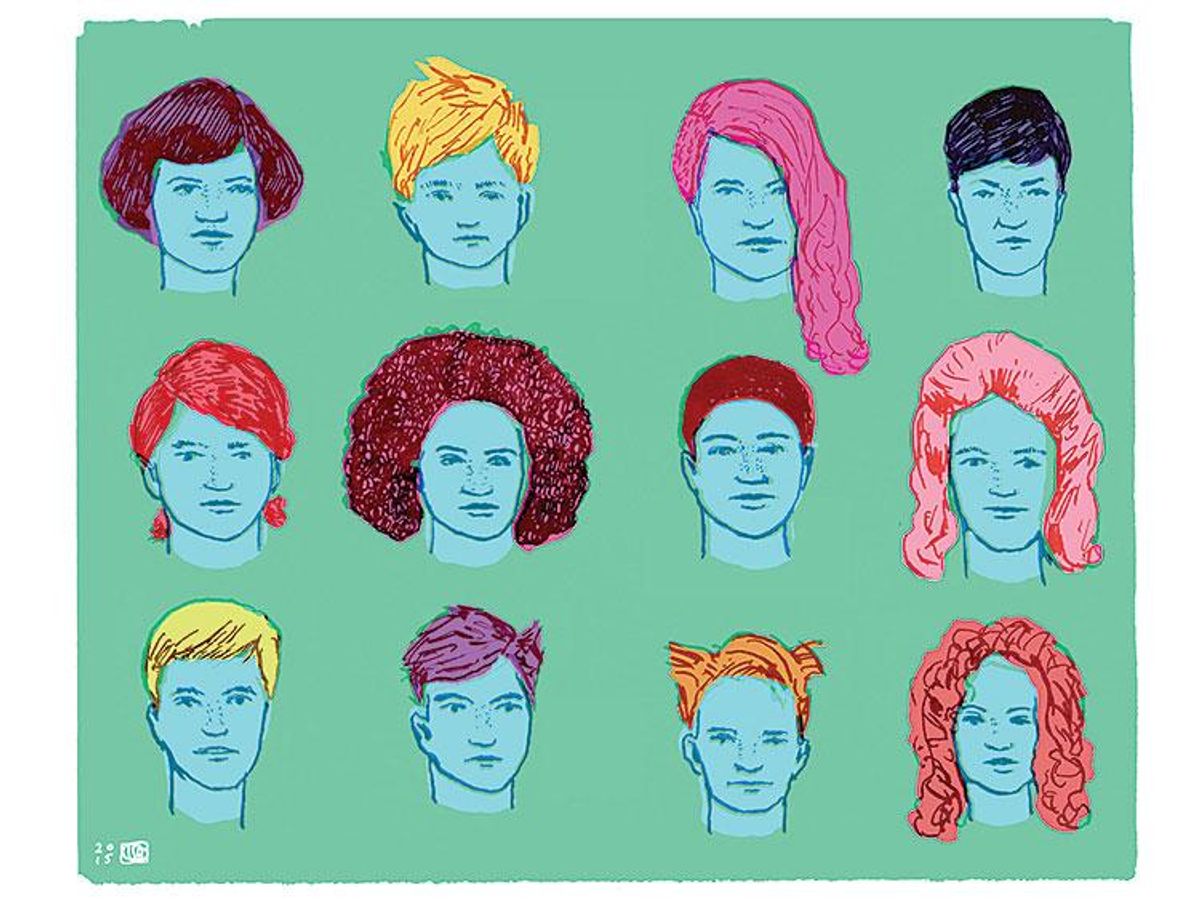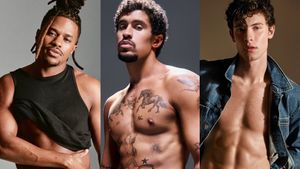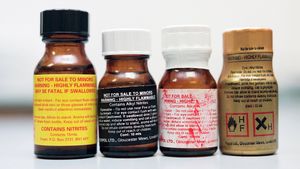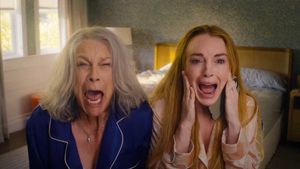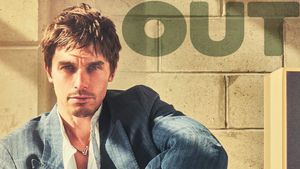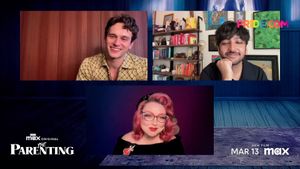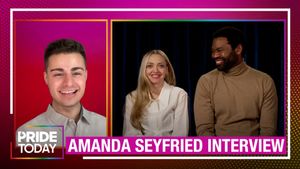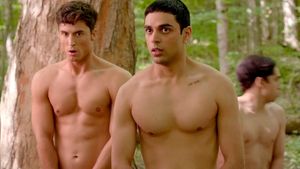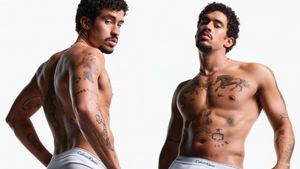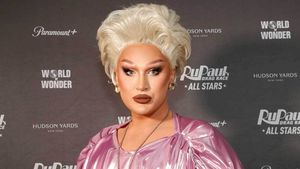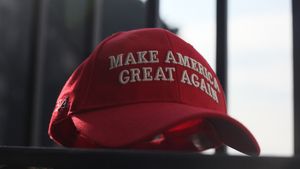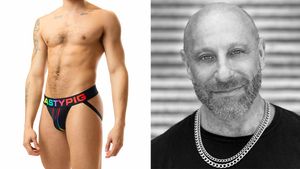I don't know if she's a lesbian," comedian Kate Clinton used to say of a prominent member of the Clinton administration whose name rhymes with Beano, "but her hair is."
Everyone knew what she meant. Lesbians are as diverse as humanity itself, but the world seems to think we all sport the same hairstyle.
For many people, "lesbian hair" means short hair. Before it became acceptable to call a lesbian a lesbian, writers often indicated a character's sexual orientation by dropping hints by way of her coiffure. In A Murder Is Announced, first published in 1950, Agatha Christie writes that Miss Hinchcliffe "turned her head with its short man-like crop and weather-beaten countenance toward her friend." That was the only clue readers needed to figure out the true nature of the friendship Miss Hinchcliffe enjoyed with Miss Murgatroyd.
Getting a haircut is a lesbian rite of passage. In Vin Packer's 1958 pulp novel The Evil Friendship, young Mary Drew Edlin bobs her hair and immediately experiences liberation: "It gave her face...a Puckish look, and with Tony's black wool scarf wrapped around her neck, it made her feel romantic, slightly daring, and good-looking." Still, Mary Drew knew that some people would respond less favorably to the new style. Immediately after shearing off her locks, she realizes, "It would kill her mother!"
Even today, the way we wear our hair is one of the more obvious ways we signal -- to other lesbians and bi women and to the world at large -- that we're queer. Soccer great Megan Rapinoe recently told ESPN The Magazine that even before she officially came out, she "looked a little gay. I had short hair." Consequently, when she did make her big announcement, "it wasn't a huge surprise to people."
Of course, the short back and sides isn't the only hairstyle that pings people's gaydar. Mullets, ponytails, dreads, and braids can all serve as a way to announce, I am lesbian, hear me roar. An insouciant lack of styling can also send up the Sapphic Signal. In lesbian romance novels, the hot butches never use product (or wear bras). They just step out of the shower and run their fingers through their hair, yet somehow they always seem to end up with a Superman-like curl falling sexily onto their foreheads.
Not all women with short hair are lesbians, but most women with short hair are regularly read as lesbians. A heterosexual friend who wears her hair short, partly because she has killer cheekbones and partly because her job requires a lot of travel, informs me that she is constantly taken for a lesbian because of her gamine cut -- including by people who should know better.
It should also go without saying that many women with long or intricately styled hair really are lesbians. In the movie Freeheld, Laurel Hester, played by Julianne Moore, is constantly shown adjusting her Farrah Fawcett flip -- or keeping her girlfriend waiting while she works her magic with a blow dryer. A glimpse at the short documentary that Freeheld is based on reveals that the real Laurel Hester wore her hair that way -- as she was deeply closeted on the job, maintaining that fancy feathered hairstyle was one of the strategies she employed to make her co-workers believe she was heterosexual.
Lesbians and bi women who tend more toward the feminine have to work harder to signal "not straight." Slate's Christina Cauterucci described getting a side shave -- long on the right, scalp showing on the left--in part because she was envious of "the knowing smiles and nods my butcher friends got from other queer women on the street." (She abandoned the cut when it entered the heterosexual mainstream.)
Between 1983 and 2008, when the comic strip "Dykes to Watch Out For" ran in feminist magazines and alternative newspapers, no one paid more attention to lesbian hair than its creator, Alison Bechdel. When I asked Bechdel how she came up with her characters' coiffures, she recalls neurotic Mo's origins more easily than the rest, because "she had the same haircut I had at the time." Trend-conscious Lois went through several styles. She started with a crew cut, briefly sported a hairstyle based on 1992 presidential candidate Ross Perot's -- which, Bechdel says now, "was just too weird, it never looked right" -- until she joined the Lesbian Avengers in 1993 and adopted the big swooping forelock she kept until the strip came to an end.
Bechdel was conscious of trying to balance butch and femme looks: Readers gave her grief for not drawing enough femme women, even though she found their hairstyles endlessly challenging. "Toni's mullet just had a lot of flowing things that I could never draw right," and Sparrow's hairstyle "had a puffiness to it that I never quite understood. Every time I drew it, I was just winging it, hoping it turned out," she says. Bechdel also noted that unlike some of the other characters' dos, Mo's hair didn't go out of date. What's never in style can never go out of style. It's that timelessness that appeals to many queer women. (Of course, as someone whose instructions to her hairdresser are, "Short; yes, really short," it's possible that I prefer that explanation to admitting that I'm just too lazy to keep up with trends or to maintain a do that requires more than the occasional application of a comb.)
The stereotypical association of lesbians with short hair doesn't necessarily apply to black women. Hair salons and barbershops are the most segregated spaces in America -- and white women like me are often ignorant of the signifiers of black hair. If television is the way that new stereotypes are created, African-American lesbians will soon be associated with long hair. Black lesbian characters on Sense8, Master of None (in which stud Denise is played by out actress Lena Waithe), Marry Me, The Fosters, and Rosewood all have or had flowing locks. Only Poussey and Suzanne on Orange Is the New Black, Mary Charles on Survivor's Remorse, and Annelise on Grandfathered wear shorter styles -- though Poussey's buzz is the only look that would register as dykey in Middle America. Then again, television is hardly a bastion of butch looks; Orange Is the New Black's Big Boo is the only truly butch dyke on television, but that's a topic for another day.
A couple of months ago, I found myself at a fancy premiere for a new lesbian movie. Thinking I was headed to a regular old press screening, I was working my usual schlubby look: My outfit looked like a pile of rumpled clothes had come to life, and my hair -- well, I've worn it in the exact same style-free style since 1980. The rest of the crowd, many of whom weren't even born when I got my first buzz cut, were beautifully dressed. The outfits came in 50 shades of chic, but what was striking was the range of hairstyles. No matter how long they wore it; whether in braids, in dreads, or with a side shave; dyed or styled with lots of product, these dykes had done their hair. The lesbian hairstyles they are a-changing.
JUNE THOMAS writes about culture for Slate and edits Outward, the magazine's LGBTQ section. A native of Manchester, England, she now lives in Brooklyn.
